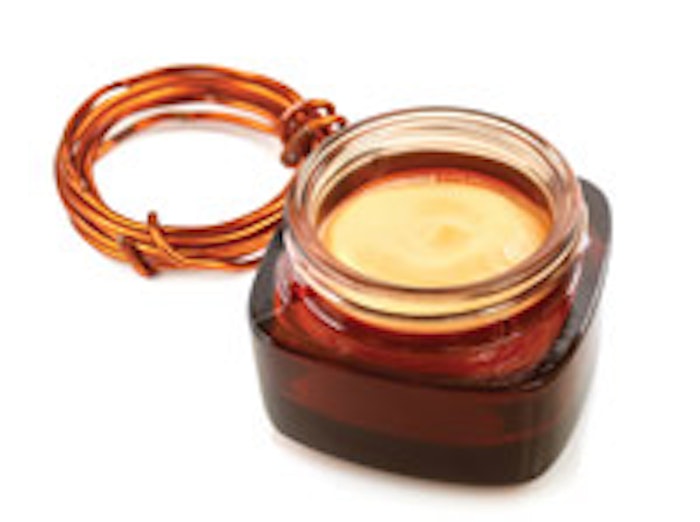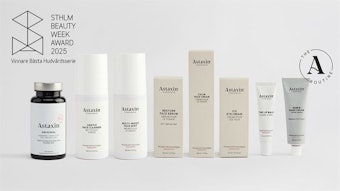
In the development of professional skin care products, the ingredients selected by the cosmetic chemist are impacted by the discovery of new raw material technologies, and their ability to enhance or work synergistically with the reliable, proven and popular ingredients that provide desirable results. It has been said that old becomes new again, and nowhere is this more evident than in the category of peptides. As new peptides have been embraced by the skin care professional, information will be added to the discussion about a new use and, perhaps, usefulness, of copper, a cosmetic ingredient that has been around since the time of Nefertiti herself.
Brief history
Copper was one of the first metals used in cosmetics in ancient Egypt. Copper oxide is a green compound, known as malachite, initially used as an eye shadow. Lead sulfide, known as galena, was used to produce the color black. There is little in the written history of cosmetics that shows copper being used for anything other than makeup, although it was used medically in the treatment of certain conditions. For hundreds of years, copper and copper compounds have been used empirically by experimenting with treatment of a variety of diseases. There is mention of the use of copper in the Ebers papyrus, one of the oldest medical manuscripts in the world. The 20th century saw no other use for copper compounds until scientists isolated a sequence of amino acids (glycyl-L-histadyl-L-lysine (GHL-Cu)—a peptide) in a human serum that bound copper. In 1973, Loren Pickart, PhD, who was studying the biochemistry and physiology of aging, found that the copper peptide GHL-Cu was abundant in young people, but present in much lower levels in older people. Throughout the next 10 years, he worked to establish many favorable properties of the copper tripeptide. In 1983, Pickart applied for a number of patents in the area of wound-healing and hair growth. An interest in wound-healing was soon tied to the role of copper in the synthesis of both elastin and collagen.
Collagen synthesis
The synthesis of collagen is quite complex, but a key enzymatic reaction involves copper and the enzyme lysyl oxidase. Lysyl oxidase is an extracellular copper enzyme that catalyzes the formation of aldehydes from lysine residues in collagen and elastin precursors. Being highly reactive, they undergo spontaneous chemical reactions with other lysyl oxidase-derived aldehyde residues, or with unmodified lysine residues. This action forms the basis of the crosslinking of collagen and elastin, an essential process for the stabilization of collagen fibrils, and for the integrity and elasticity of mature elastin. There are other complex crosslinks, some formed in collagen (pyridinolines derived from three lysine residues) and some in elastin (desmosines derived from four lysine residues) that differ in structure. The absence of crosslinking results in lathyrism, which is characterized by poor bone formation and strength, hyperextensible skin and weak ligaments.
Collagen, the main structural protein of connective tissue, is the most abundant tissue in animals—including humans—comprising 25–35% of whole-body protein content. The name “collagen” comes from the Greek kolla meaning “glue” with the suffix -gen denoting “producing.” The fibroblast is the most common cell that creates collagen. Collagen occurs in many places throughout the body. Although 28 types of collagen have been identified, more than 90% of the collagen in the body is type I.
The five most common types of collagen are:
- Collagen I—found in skin, tendons, vascular ligatures and organs, is the main component of the organic part of bone, while calcium is the mineral part;
- Collagen II—the main component of cartilage;
- Collagen III—a reticulate, commonly found alongside type I;
- Collagen IV—essential for binding the epidermis to the dermis as it forms the basal lamina, the epithelium-secreted layer of the basement
membrane; and - Collagen V—found on and in cell surfaces, hair and placenta.
Copper peptides
What does copper actually do on the skin? Copper, in the form of bound peptides, has been available to the cosmetic industry for many years. Initially a bipeptide, it was marketed as an anti-aging product in facial creams. The goal of the copper peptide is to stimulate collagen and elastin formation. It does this by increasing the enzyme lysyl oxidase. As long as the compound remains bound to the amino acids, it would appear that this preparation would be essentially devoid of free-radical activity. A newer version of the copper peptide, containing only two amino acids—lysine and histidine—is now also available: Neodermyl. Many in vitro and in vivo studies for this product have shown it to be effective in reducing visible signs of aging. Induchem, the ingredient’s supplier, makes the claim that Neodermyl “re-energises senescent fibroblasts by supplying them with an activated source of cellular energy.” If this claim can be proven, the pathway of research using peptide biology will gain significant advances, and will surely continue to be a promising avenue in the treatment of aging skin.
With cosmetic formulations containing naturally derived herbs, vitamins and oils, a topically applied active ingredient is only as good the vehicle through which it is delivered, the use of its correct form and the effective concentration.
Copper as a transition metal
In the body, free copper ions are not normally available, but are bound tightly to serum albumin, or incorporated into the copper-carrying compound known as caeruloplasmin. The tendency of copper ions to bind readily to amino groups of proteins would seem to indicate that proteins will thus prevent copper ion-dependent hydroxyl ion formation. Actually, the free-radical generation is not prevented, but rather localized to the site of the copper ions, and the protein molecule itself will be damaged by the hydroxyl (OH) radicals—among the most destructive. Histidine residues have been particularly implicated as sites of copper ion-dependent protein degradation. In fact, the effect of complexing catalytic metal ions on OH radical production is not readily predictable. It is interesting that chelating agents may both promote and inhibit metal ion-dependent OH radical formation, depending on a number of factors. These may include the solubility of the complex; the redox potential of the metal and, consequently, its ability to be reduced by oxygen; and finally, whether or not it has a free coordination site, enabling it to catalyze peroxide breakdown.
New shine to the market
The anecdotal therapeutic uses of copper combined with the proven clinical effectiveness of copper peptides allow a potential for this ancient beautifying metal to bring a new shine to the professional skin care marketplace.
GENERAL REFERENCES
B Alberts, Molecular Biology of the Cell, Garland Science, New York (2002)
K Csiszar, Lysyl oxidases: a novel multifunctional amine oxidase family, Prog Nucleic Acid Res Mol Biol 70 1–32 (2001)
RC Siegel, JC Fu, et. al., Collagen cross-linking: lysyl oxidase dependent synthesis of pyridinoline in vitro: confirmation that pyridinoline is derived from collagen, Biochem Biophys Res Commun 108 4 1546–1550 (Oct 1982)
RT Dean, A mechanism for accelerated degradation of intracellular proteins after limited damage by free radicals, Febs Letters 220 278–282 (1987)
JMC Gutteridge, Antioxidant properties of caeruloplasmin towards iron- and copper-dependent oxygen radical formation, Febs Letters 157 1 37–40 (June 1983)
E Graf, JR Mahoney, RG Bryant and JW Eaton, Iron-catalyzed hydroxyl radical formation. Stringent requirement for free iron coordination site, J Biol Chem 25 259 6 3620–3624 (Mar 1984)
HHA Dollwet and JRJ Sorenson, Historic uses of copper compounds in medicine, Trace Elem Med 2 80–87 (1985)
Michael Q. Pugliese became the third-generation CEO of Circadia by Dr. Pugliese, Inc. in 2006. He is a licensed esthetician and a member of the Society of Cosmetic Chemists, who regularly attends its educational events to stay on the cutting-edge of new product development.
Editor’s note: Don’t miss Michael Q. Pugliese’s class about “Sunscreen Technology and Regulatory Updates” during the Advanced Education Conference Program at Face & Body® Northern California in San Jose, CA, on Saturday, August 23! Register today at www.FaceandBody.com/california!










